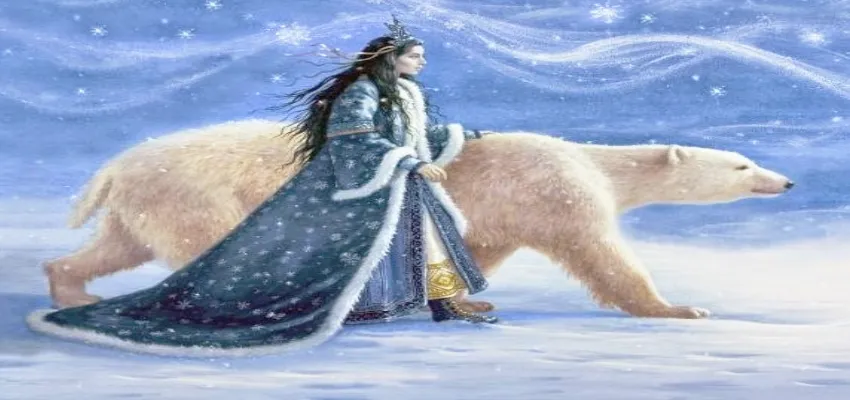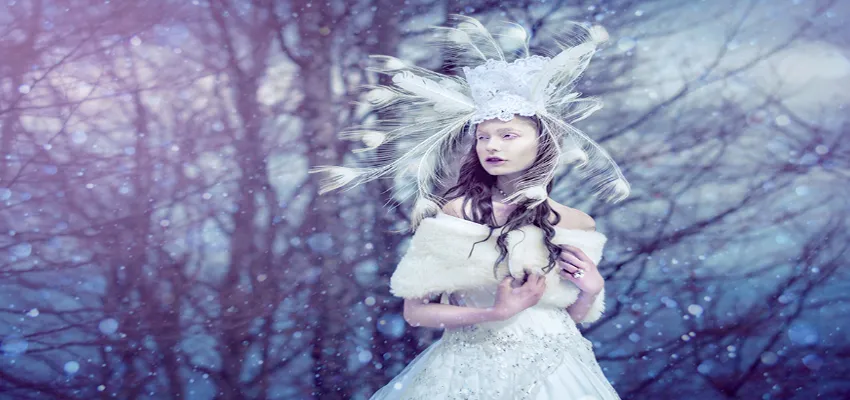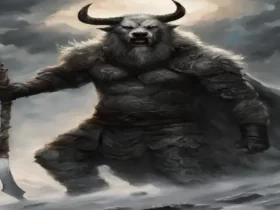We’re exploring the magic of winter and the goddess who embodies its essence. From snowy landscapes to icy waters, winter offers a unique and enchanting experience that can be both calming and energizing. So, let’s dive into the list of 10 famous winter goddesses from different mythologies of the World.
1Skaði (Norse Winter Goddess of Hunting, Skiing, and Justice)

Skaði’s love of the mountains and her skill in hunting and skiing made her a revered figure among the Norse people. She was known for her courage and independence, and for her ability to survive in the harshest of winter conditions. In fact, she was often depicted wearing skis, a symbol of her mastery of the snowy landscapes she called home.
Skadi was a giant in Norse mythology who sought revenge for her father’s death by attacking the rival tribe of the gods in Asgard, home of the gods. The Aesir offered her the choice of a husband from among them, but she could only choose by looking at their legs. She chose Njörd, thinking he was Balder, but their marriage failed because she preferred the mountains while he preferred the sea. In some accounts, Skadi was also known as the goddess of snowshoes. In another tradition, she married Odin and had sons with him.
Skaði is a complex and powerful figure in Norse mythology. As a goddess of winter, hunting, skiing, and justice, she embodies the challenges and rewards of the season. Her independence, strength, and skill make her a symbol of resilience and determination, and her impartiality and sense of justice remind us of the importance of fairness and balance.
2Marzanna or Morana (Slavic Goddess of Winter, Death, and Rebirth)

Marzanna’s story begins with the coming of winter. In Slavic mythology, Marzanna is associated with the dying of the old year and the rebirth of the new. She is often depicted as a hag-like figure, draped in rags and carrying a bundle of sticks or twigs. In some traditions, she is burned or drowned in effigy, symbolizing the end of the old year and the beginning of the new.
But Marzanna is more than just a symbol of the changing seasons. She is also a goddess of death and rebirth, associated with the mysteries of the afterlife and the cycle of birth, growth, decay, and renewal. In some versions of her story, Marzanna is the daughter of the god of death, and she is responsible for guiding the souls of the dead to their final resting place.
Despite her association with death and the afterlife, Marzanna is not a fearsome figure. Instead, she is often portrayed as a wise and nurturing goddess, who teaches her followers the importance of respecting the cycles of life and death. In some Slavic cultures, Marzanna is also associated with fertility and the renewal of the earth, as the melting of the winter snows brings new life and growth to the land.
As winter comes to an end and spring approaches, the Slavic festival of Maslenitsa takes place. During this festival, a straw maiden is dressed in rags and carried through town into the fields, where she is either burned in effigy or drowned in a river or pond. This effigy represents Marzanna, the winter goddess of death and rebirth, and its destruction symbolizes the banishing of winter from the land. Alternatively, the drowning of the effigy represents Marzanna’s disappearance into the underworld.
As winter draws near, Marzanna is linked with the myth of the “enchanted huntsman.” According to a tale told by the Roma, a hunter (sometimes identified as the god of the sun) falls in love with Marzanna, and she captures his soul in a magical mirror, forcing him to spend the long winter there, similar to the story of Persephone in Greek mythology.
Marzanna, also known as Mara or Mora in some tales, is a fate-goddess who is associated with destruction and death. She is often depicted as a monstrous hag who rides the night winds and drinks the blood of men. Similar to the Hindu goddess Kali, Marzanna is also a personal tormentor who sometimes takes the form of a horse or a tuft of hair. There is a tale of a man who is followed by Marzanna wherever he goes until he is suffocated by a tuft of white hair, which turns out to be Marzanna herself.
3Chione (Greek Goddess Of Snow & Cold Air)

Chione was a minor goddess in Greek mythology and the daughter of the North Wind. She personified the force of nature she represented, being the goddess of snow and closely linked to the cold air and storms brought in by her father. Chione had a son, Eumolpus, with Poseidon, whom she cast into the sea in fear of her father’s wrath. The Eumolpidae claimed descent from her, and she was hardly ever represented in mythology. In some myths, she had a daughter, Sais, with an unknown man who was killed by the Fates at birth. Chione also had an affair with Apollo and boasted of being better than Artemis, leading to her punishment either by being pierced or protected by the power of Poseidon and Apollo, depending on the version of the myth.
Note: Point 3 and Point 5 Goddesses Are Same, One Represent Greek Myths While Later Romans. It can be challenging to distinguish between individuals when using their Greek or Roman names.
4Cailleach (Celtic Goddess Of Winter)

The Cailleach was a Celtic goddess associated with winter, cold, and storms. She was known by different names and titles in Scotland, Ireland, and the Isle of Man, but her most prominent title was Cailleach Bhéara. She was often depicted as an old woman, sometimes with one eye and adorned with skulls. She could transform into a giant bird and control storms and thunder with her hammer. While she was a natural destructive force, she also cared for animals during the winter months. She was ageless and immortal, able to return to youth each winter season.
The Cailleach is typically associated with two things: being a hag and representing winter. However, she has more depth and various associations. Jacqueline Simpson, in her book European Mythology, describes the Scottish version of the Cailleach Bheur as a tall, blue-faced old woman who embodies winter and also protects wild animals. She is known for fostering children who would establish tribes, and is associated with the fertility of crops, particularly grain, which was symbolized by the last sheaf of the harvest. This sheaf was believed to be imbued with a corn spirit that embodied the crops, and in regions where the Cailleach was venerated, the corn spirit was often thought to be the Cailleach herself.
5Kheimon (Roman Goddess Of Snow And Winter)

Khione, (is same goddess as Chione in Roman myths) the daughter of Boreas, the Greek god of the North Wind and Winter, is the goddess of snow and the sister of Zethes and Calais. Although she is typically depicted as a goddess, some myths portray her as a snow nymph. In Roman mythology, Chione is sometimes used as an alternative spelling of her name. Khione has the ability to turn people into ice sculptures and was loved by Poseidon, with whom she bore a son named Eumolpus. She feared her father’s wrath and threw her child into the sea, but Poseidon saved him and entrusted him to Benthesikyme. The Eumolpidae claimed descent from her as the mother of Eumolpus. Khione was rarely represented in Greek or Roman mythology, but some myths suggest she had a daughter named Sais, who was killed by the Fates at birth. She also had an affair with Apollo and boasted of her superiority over Artemis. Some versions of the myth suggest that her pride led to her downfall, while others claim that she was protected by the power of Poseidon and Apollo.
6Despoina (Greek Winter Goddess)

Despoina, a goddess of winter and frost, is known to be more powerful than Boreas and Chione. However, she is not ranked higher on the list of winter gods because her blessings do not necessarily bring snow or winter. Her parentage involves Demeter and Poseidon, with her conception occurring as Demeter fled from Poseidon in the form of a mare while he pursued her as a stallion. This event resulted in a global famine before Despoina and Arion were born. Despoina is an important figure in Greek history due to her cult, the Cult of Despoina, which focused on the significance of nature and animals. While one could pray to her for winter, snow and her blessings may result in more ice than desired.
7Beira (Scottish Goddess Of Winter)

Beira, also known as Dark Beira, was the mother of all gods and goddesses in Scotland. She was extremely old, tall, and feared by everyone. During winter, she ruled as the Queen of the Four Red Divisions of the world, and her power was absolute. However, her subjects longed for the coming of the Summer King and his queen, as they were the bringers of plenty and happy days. Beira did not want to lose her power, so she tried to prolong winter by sending blighting frost and raising spring storms.
Beira lived for hundreds of years by drinking from the magic waters of the Well of Youth, which was located on a floating island in the west. This island drifted around the Atlantic and was difficult to find. Beira always visited the island on the night before the first lengthening day of spring, when the magic waters were most potent. She had to drink the water before any bird visited the well or any dog barked, or else she would crumble into dust. After drinking the water, she grew young again and fell into a magic sleep before waking up as a beautiful girl with yellow hair, red cheeks, and blue eyes. However, as each month passed, she aged quickly, and when winter returned, she became an old and withered hag once again.
8Poli’ahu (Hawaiian Goddess Of Snow)

While snow is not a common occurrence in Hawai‘i, the peak of Mauna Kea is often covered in a layer of snow during the cooler winter months. Legend has it that there is a Snow Goddess named Poli‘ahu who resides on the summit of Mauna Kea. Poli‘ahu is the eldest daughter of Wākea and Kāne and is also the sister and rival of Pele, the Fire Goddess of Hawai‘i. According to the legend, Poli‘ahu wears a cloak made of fine white kapa that she drapes over the mountain to create the snow.
The legend goes on to tell of a time when Poli‘ahu and her sisters were sliding down the slopes of Mauna Kea and a stranger asked to join them. Poli‘ahu won the competition and the stranger was revealed to be Pele, who became so angry that she started spewing hot lava out of the mountain. To stop the lava, Poli‘ahu released her snow and her sisters released their underground lakes, while Lilinoe, the goddess of mist and rain, created a blanket of mist that Poli‘ahu turned into snow. Pele’s lava was then transformed into hard black lava rock.
Today, Poli‘ahu’s blankets of snow can be seen on the summit of Mauna Kea from November through March. It is important to tread lightly and respect the Snow Goddess’s habitat if you are fortunate enough to witness the glistening snow.
9Tengliu (The Chinese Goddess Of Snow & Winter)

China has a rich and diverse past with various religions and cultures. In Chinese mythology, it is believed that the primordial creator god was Pan Gu, who emerged from a cosmic egg in the void and created the earth and sky over a span of 18,000 years. After his death, his body transformed into the basis for all life and gods, with his blood forming rivers and his head becoming mountains. Following Pan Gu, other gods and goddesses emerged and came to embody various elements. Tengliu, the goddess of snow, is a prominent figure in Chinese mythology and culture, featuring prominently in songs, fu, and sculptures.
10Nane Sarma – The Iranian Grandma Of Winter

The legend of Nane Sarma is a beloved tale in Persian folklore. According to the story, Nane Sarma was a beautiful young woman who fell in love with Amu Nowruz, the Persian New Year’s Day. However, their love was forbidden, and they were cursed to only see each other one night each year.
Nane Sarma was heartbroken and spent the rest of the year pining for Amu Nowruz. But as the end of summer approached, she found solace in summoning the cold winds and the snow. She began to embrace the cold and the winter, finding comfort in the fact that Amu Nowruz would soon visit her once again.
As winter approached, Nane Sarma would prepare for Amu Nowruz’s arrival, adorning herself in her finest clothes and jewelry. On the night of his visit, they would embrace and spend the night together, reveling in their love.
As the dawn broke, Amu Nowruz would be forced to leave, and Nane Sarma would be left alone once again. But she found joy in knowing that he would return the following year, and that their love would endure.
The legend of Nane Sarma is often told as a story of forbidden love and the beauty of winter. It has become a beloved tale in Persian culture and is often associated with the arrival of the winter season and the celebration of the Persian New Year.





